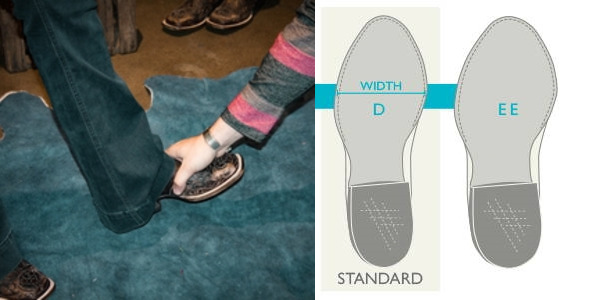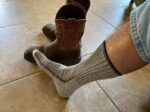For the uninformed, navigating boot sizes may be a perplexing jumble of numbers and letters. There are multiple boot sizing measurements in the US and Europe, as well as distinct sizing standards for men and women, and there is practically no genuine industry standard you can rely on.
Within this jumble of size terminology, however, there is another set of classifications that is sometimes overlooked, it’s the width of the boot.
It’s just as vital to get the width of your boot perfect as it is to get the length appropriate for comfort.
Getting a size D or EE width boot completely depends on a person’s foot characteristics. Size D is medium for men, and a wide size for women, and EE width shoes are wide for men and extra wide for women. You have to measure your width size properly along with the length before you purchase boots.

I know sizing can be confusing, especially if you’re jumping from one brand to the other. But width sizes aren’t just limited to D or EE, therefore, we have curated a chart for you along with various other sizings and their details.
In the US, there are different boot widths, each denoted by a different combination of letters indicating whether the boot is narrow, medium, or wide.
There are, of course, exceptions to this scale if it wasn’t complicated enough already.
| Width size | Meaning |
| AAA | Extreme narrow |
| AA | Very narrow |
| A | Narrow |
| B | Narrow |
| D | Medium |
| EE | Wide |
| EEE | Extra Wide |
Now let us understand these sizes in detail:
A width- The A width is most commonly found on women’s footwear that are specifically suited for tiny feet, and it is seldom seen on men’s footwear due to the small number of men that have narrow width.
A width shoes are generally between 3.4 and 3.9 inches wide at the ball of the foot.
Women’s boots with an AA or AAA width are also popular, and are somewhat narrower, however the difference between A and AAA boots is primarily determined by the manufacturer’s specifications.
B width- For women’s footwear, the B width is normal, but for men’s, it would be considered excessively small. If a pair of women’s boots isn’t explicitly labelled as broad or narrow, chances are they’re B width.
At the ball of the foot, B width boots are generally 3.6 to 4.1 inches wide.
D width– D shoe widths men is regarded as medium, whereas for women’s boots, it is considered broad. Footwears that aren’t labelled as broad or narrow for men are generally D width.
D width corresponds to 3 to 5 inches across the ball of your foot, but is most commonly 4 to 4.5 inches wide.
E width- For men’s footwear, the E width is standard, but for women’s, the E width is considered extra-wide.
For men’s boots, it generally measures between 4.2 and 4.7 inches across the ball of your foot, although it may be anywhere from 3.2 and 5.2 inches wide.
EE width- EE width is the largest width on the conventional scale and is considered extra-wide for men’s footwear. EE width boots are generally 4.4 to 4.9 inches broad, although they can be anywhere from 3.4 to 5.4 inches wide.
Shoes Width size chart
| Size | B | C | D | E | EE | EEE |
| 4 | 2.9 | 3.1 | 3.3 | 3.4 | 3.5 | 3.8 |
| 4.5 | 2.9 | 3.1 | 3.3 | 3.5 | 3.7 | 3.9 |
| 5 | 3 | 3.2 | 3.4 | 3.6 | 3.8 | 3.9 |
| 5.5 | 3.1 | 3.3 | 3.4 | 3.6 | 3.8 | 4 |
| 6 | 3.1 | 3.3 | 3.5 | 3.7 | 3.9 | 4.1 |
| 6.5 | 3.2 | 3.4 | 3.6 | 3.8 | 3.9 | 4.1 |
| 7 | 3.3 | 3.4 | 3.6 | 3.8 | 4 | 4.2 |
| 7.5 | 3.3 | 3.5 | 3.7 | 3.9 | 4.1 | 4.3 |
| 8 | 3.4 | 3.6 | 3.8 | 3.9 | 4.1 | 4.3 |
| 8.5 | 3.4 | 3.6 | 3.8 | 4 | 4.2 | 4.4 |
| 9 | 3.5 | 3.7 | 3.9 | 4.1 | 4.3 | 4.4 |
| 9.5 | 3.6 | 3.8 | 3.9 | 4.1 | 4.3 | 4.5 |
| 10 | 3.6 | 3.8 | 4 | 4.2 | 4.4 | 4.6 |
| 10.5 | 3.7 | 3.9 | 4.1 | 4.3 | 4.4 | 4.6 |
| 11 | 3.8 | 3.9 | 4.1 | 4.3 | 4.5 | 4.7 |
| 11.5 | 3.8 | 4 | 4.2 | 4.4 | 4.6 | 4.8 |
| 12 | 3.9 | 4.1 | 4.3 | 4.4 | 4.6 | 4.9 |
| 13 | 4 | 4.2 | 4.4 | 4.6 | 4.8 | 5.1 |
| 14 | 4.1 | 4.3 | 4.5 | 4.7 | 4.9 | 5.1 |
How to identify your recommended size?
There are no two feet that are the same. Obviously, recommending sizes is tricky because only you know what feels good on your feet.
Some people like a wide fit, while others prefer a boot fit tight. Comfort and feeling are quite subjective, and it is truly a personal choice.
As part of our dedication to providing you with as much knowledge so that it’s a smooth sail for you, it is ultimately you who can decide best for yourself.
Although we cannot promise that a certain design or size will fit, here is some basic advice to help you discover the right fit.
→ Have your foot measured whenever possible.
→ If you’re familiar with a certain boot brand, purchase the same size as you typically do.
→ If you have boots from other manufacturers, this size will typically suffice.
→ If this is your first pair of boots, choose half a size smaller than your regular boot size.
→ If you’re in between sizes, go up a half size.
You can also measure your foot at home to identify what shoe width size works best for you. Here we provide you with some tips:
How can I measure my shoe width?
To choose boots that are the correct width for your feet, follow these steps:
1.) Wrap a tape measure around your bare foot’s widest area.
2.) As though you were standing normally, place one foot on the ground.
3.) On the tape measure, write the breadth of your foot in millimetres.
4.) Determine the boot width you require using this measurement.
Is EE or D wider in boots?
The D width is typically 3 to 5 inches across the region of your foot’s ball and EE shoe widths typically range from 3.4 to 5.4 inches across the ball of the foot, depending on foot and shoe size. Therefore, EE is clearly wider than D in boots.
What is the difference between D and EE in cowboy boots?
Since D stands for medium width, it is medium around the feet and the ankle. And EE stands for wide feet, which means it is wider on the vamp and instep.
How do I know what width boot I need D or EE?
D-width is considered a medium size for males and a wide size for ladies. Men perceive E widths to be broad, whereas women consider them to be extra-wide.
EE width shoes are exceptionally broad for both men and women. Therefore, in order to know which size is apt for you, always consider looking at a size chart for reference before you buy boots.
How wide is an EE Boot then D Boot ?
The D width is typically 3 to 5 inches across the region of your foot’s ball and EE shoe widths typically range from 3.4 to 5.4 inches across the ball of the foot. This means the difference is somewhere around 1/4th of an inch between the two.
Is the women shoe width size same as men?
The shoe size difference between women’s and men’s shoes is 1.5. But when it comes to width, D is a medium for males and a broad size for women. EE width shoes are broad for men and extra wide for women.
FAQs-
What are some ways to tell if you need a wider boot?
Stretching or bulging on the outside of the forefoot is the most noticeable symptom. Your shoe is probably too small if your foot is clearly broader than the bottom of the shoe and extends past the sole.
What is the average/normal width?
Approximately 90% of the most common width is normal width. If you don’t know your foot width, you’re probably wearing a standard width boot, which is a B for women and a D for men. The width of a boot is usually only noted if it differs from the standard.
To put it another way, most footwear will not be labelled with a B (women) or D (men) to signify normal width. If a boot isn’t labelled with a width, it’s most likely a standard width.
Will you have the same width size all your life?
Well no, your width size is likely to change (become wider) once you reach a point when you stop growing. It also depends on your weight. Also, pregnancy or diabetes can both impact the width size of the feet.
What will happen if your boot size is too wide or too narrow?
Narrow shoes can cause infected foot sores, painful blisters, hammertoes, and bunions, among other health problems. Cramps and profuse sweating are also frequent, which can lead to bacterial or fungal infections.
And if the boots are too wide, it is likely to rub against the back of your heel causing friction that might lead to callus or possibly a bone spur.
When you walk, you won’t feel as steady, and your feet will wander about in your shoes, causing friction and leading to sores and blisters. Overly-wide shoes are also known to cause nail problems and hammertoes.
When to know if your boots are of the right size?
You’ll know your boots fit you well when:
1.) Your feet’s edges and bottoms are exactly aligned with the footbeds.
2.) The heels are firmly planted in the heel cup.
3.) Your toes have adequate room in the toe box to prevent them from rubbing against the boots.
4.) When you’re wearing the right fit, your feet don’t droop over the sidewall.
5.) You don’t feel squeezed or restricted on the sides of your feet.
Conclusion
Since we have discussed the importance of a proper fitting footwear, you need to try on the sizes for yourself and use the width sizes as a suggestion rather than an exact measurement before you purchase a boot.







